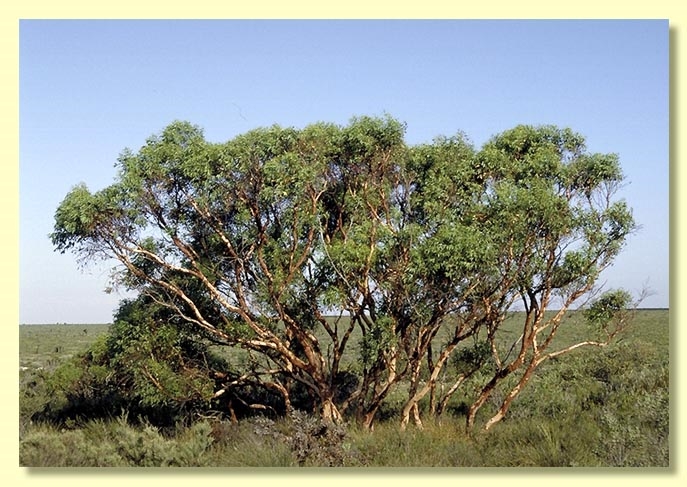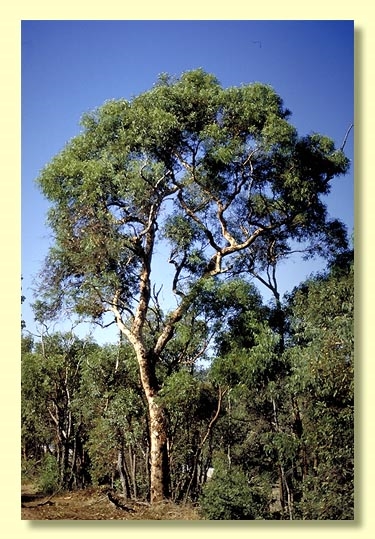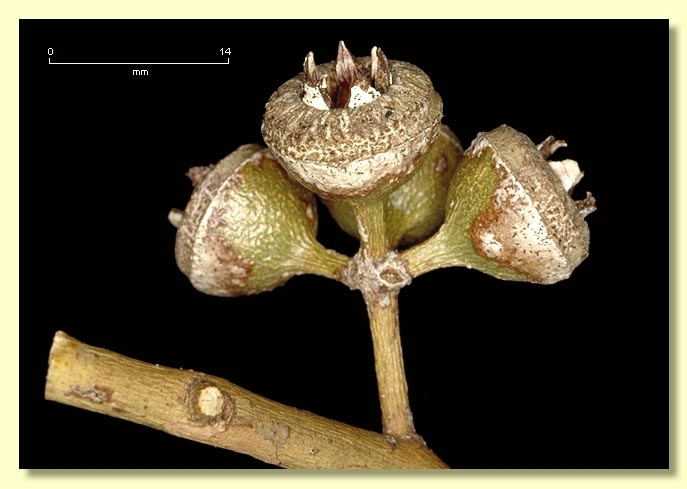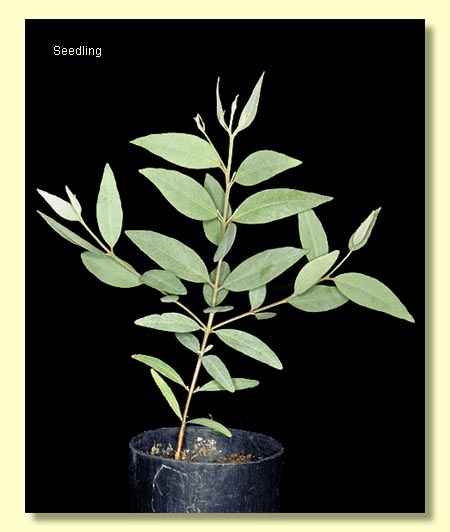Eucalyptus | Symphyomyrtus | Bisectae | Destitutae | Curviptera | Inflexae
Euclid - Online edition
Eucalyptus lane-poolei
Bark smooth throughout but often appearing scaly with partly shed plates or flakes of red-brown bark over white to pinkish yellow or pale orange.
Branchlets lacking oil glands in the pith.
Juvenile growth (coppice or field seedlings to 50 cm): stems rounded to square in cross-section; juvenile leaves shortly petiolate, sub-opposite at lower nodes, then alternate, ovate, 3–9 cm long, 1–3.5 cm wide, dull, light green.
Adult leaves thin, alternate, petioles 0.5–1.5 cm long; blade narrowly lanceolate to falcate, (5)6.5–10(11) cm long, (0.7)1–1.7 cm wide, base tapering to petiole, margin entire, apex acute, slightly glossy, green, side-veins greater than 45° to midrib, reticulation dense, intramarginal vein close to margin, oil glands scattered, mostly intersectional.
Inflorescence axillary unbranched, peduncles 0.7–2 cm long, buds 7, pedicellate (pedicels 0.1–0.7 cm long). Mature buds globular to ovoid (0.6–1.1 cm long, 0.5–1 cm wide), scar present, operculum rounded and sometimes apiculate, stamens inflexed, anthers oblong, versatile, sub-basifixed, dehiscing by longitudinal slits, style long and straight, stigma tapered to blunt, locules 3, 4 or 5, the placentae each with 4 vertical rows of ovules but may appear to have five rows near base of cluster. Flowers white.
Fruit pedicellate to rarely sessile (pedicels 0–0.6 cm long), hemispherical, 0.7–1.4 cm long, 1.1–1.6 cm wide, with prominent thick sloping rim (scar of inner operculum) and disc that maybe level to ascending or even slightly descending, valves 3, 4 or 5, exserted.
Seeds grey-brown to brown, 1–2.5 mm long, flattened-ovoid, dorsal surface shallowly reticulate, hilum ventral.
Cultivated seedlings (measured at node 10): cotyledons Y-shaped (bisected); stems square or rounded in cross-section; leaves opposite, linear to narrowly elliptical and shortly petiolate at first, becoming alternate after 7 to 9 nodes, petiolate, ovate to lanceolate, 3–7.5 cm long, 1–2.5 cm wide, dull to slightly glossy, grey-green; apical growth slightly glaucous but not persisting.
Flowering has been recorded in April.
A small tree or mallee endemic to Western Australia, of disjunct distribution, north of Perth from Jurien Bay to Gin Gin, and in the Darling Range from Clackline to Pinjarra. The bark is smooth or with loosely held dead flakes and adult leaves are falcate, glossy, bright green.
Eucalyptus lane-poolei belongs in Eucalyptus subgenus Symphyomyrtus section Bisectae subsection Destitutae because buds have two opercula, cotyledons are Y-shaped and branchlets lack oil glands in the pith. Within this subsection E. lane-poolei belongs to the series Curviptera, a group of about 30 species characterised by large fruit with a prominent ascending disc. Within this series E. lane-poolei is somewhat isolated from other species by having inflexed stamens in the bud and by its seeds which are flattened-ovoid rather than obliquely pyramidal and flanged.
The distribution pattern of Eucalyptus lane-poolei in relatively humid coastal and subcoastal regions, the filament inflexion and seed character probably reflect its primitiveness in relation to the rest of series Curviptera. An isolated population of taller trees in jarrah forest north-west of Denmark belongs to a new species, E. virginea, closely related to E. lane-poolei. It is distinguished from E. lane-poolei by tall tree form, smaller buds, and adult leaves unusual in being slightly discolorous (paler on the underside). This latter morphological feature is generally regarded as a relict of wetter times. Yet another new species related E. lane-poolei, E. relicta, is found south-east of Busselton and is distinguished by being entirely rough-barked, having slightly discolorous leaves and small buds and fruit.
Eucalyptus lane-poolei differs from E. drummondii in having more globular buds with inflexed stamens (buds more ovoid with conical operculum, and outer stamens obliquely erect, inner stamens sometimes inflexed, in E. drummondii). The hybrid species E. balanites has E. lane-poolei as one parent, and differs in having rough bark.














